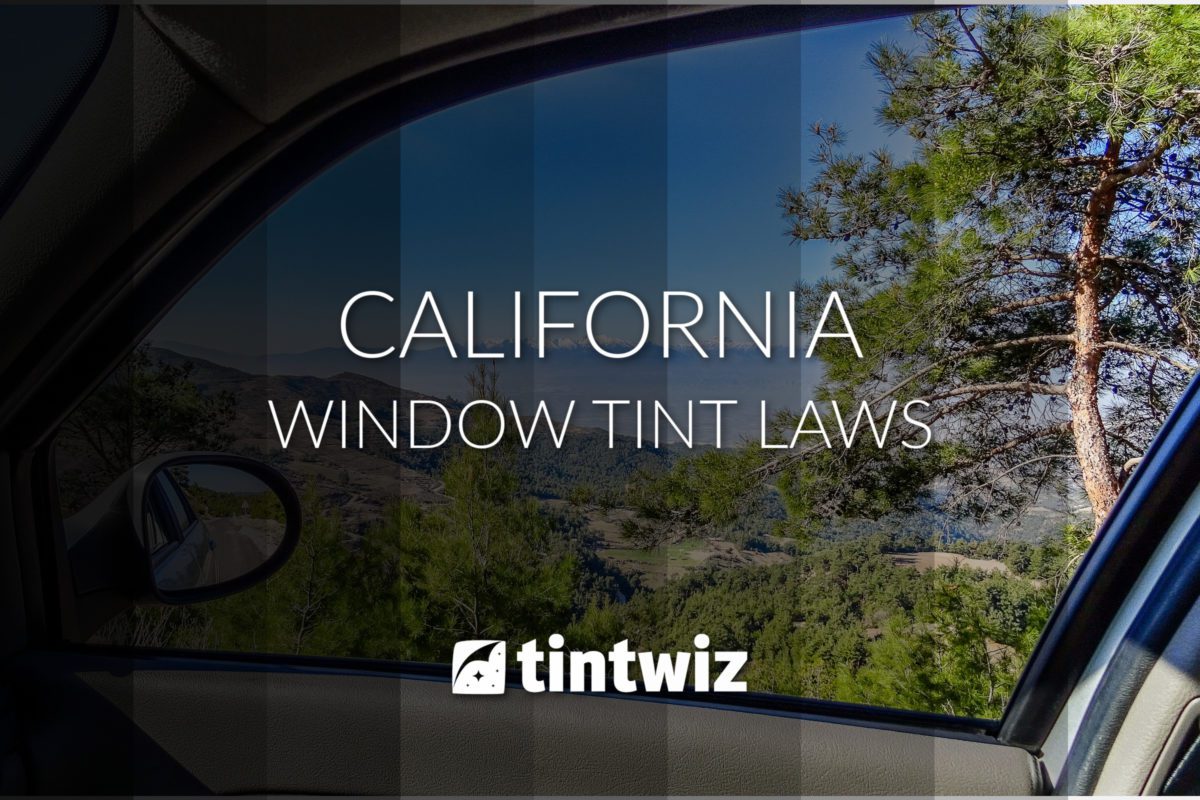Darkest legal tint for Sedans in California
- Windshield: Non-reflective tint is allowed on the top 4 inches of the windshield
- Front Side windows: Aftermarket film must allow more than 88% of light in, or minimum 70% VLT if combined with factory-tinted windows.
- Back Side windows: Any darkness can be used.
- Rear window: Any darkness can be used.
Darkest legal tint for SUV and Vans in California
- Windshield: Non-reflective tint is allowed on the top 4 inches of the windshield
- Front Side windows: Aftermarket film must allow more than 88% of light in, or minimum 70% VLT if combined with factory-tinted windows.
- Back Side windows: Any darkness can be used.
- Rear window: Any darkness can be used.
Table of contents
- Darkest legal tint for Sedans in California
- Darkest legal tint for SUV and Vans in California
- Can You Tint Your Windshield and Front Side Windows?
- How Dark Can Car Tint Be in California and Be Legal?
- California Tint Laws for Each Window of a Private Vehicle
- Window Tint Reflectivity and Tint Colors Laws in California
- Are There Medical Exemptions for California Window Tint Laws?
- How to Get a California Window Tint Exemption Application
- Getting a Window Film Certificate
- Against the Tint Law: What Window Film Regulations Prohibit
- Don’t Get a Ticket for Front Side Window Tint
- Penalties for Non-Compliance with Window Tint Laws in California
Please note: The accuracy, completeness, adequacy or currency of the content is not warranted or guaranteed. We are not lawyers or a law firm and we do not provide legal advice. We recommend you consult a lawyer or other appropriate professional if you want legal advice.

California window tint laws can be hard to keep track of because they tend to change from time to time and because new auto window tint products and brands regularly enter the marketplace and are often in a gray area as to whether they are legal window tint or not.
If you’re looking for information on new California automobile window tint laws and on what window tint is legal in California in general, you’re looking in the right place.
Can You Tint Your Windshield and Front Side Windows?
Yes, California window tint laws do allow any vehicle to have some degree of tinting on the windshield and on the front driver’s side and passenger windows, but with limitations.
To have a front windshield and the front side windows of your vehicle considered legally tinted, California tint law states the front windshield may only have a strip of tint on the top four to five inches of glass and at that least 70% of visible light must be able to pass through the tint on the side windows by the driver and front passengers seats.
These tinting restrictions apply to all types of private vehicles, from vans to trucks to sedans to SUVs. Any additional tinting (without special circumstances, as we’ll see) can lead to fines and a requirement to remove the illegal tint or else risk ever larger punishments.
How Dark Can Car Tint Be in California and Be Legal?
California window tint laws are quite specific when it comes to limiting the percentage of window tint darkness and the window tint reflection an automobile is allowed to legally have. Take care to check all laws and consult your California window tint installer before a new tint job, and know you may only have a limited time to get a car to meet California window tint code if you have brought the vehicle from another state with different car tinting rules.
The amount of visible light that passes through the window of an automobile is referred to as Visible Light Transmission (VLT) percentage. Thus tint rated at 90% is on the lighter side and is easy to see through, while a tint with a 5% VLT appears almost entirely black. (Note that in terms of total VLT, we refers to the amount of light passing through the auto glass as well as the tint film later applied, so be extra cautious with aftermarket window tint if your vehicle already has some tinting to the windows.)
The California window tint laws requirements are for a vehicle’s front windshield and front side windows to have a 70% VLT or lighter. California car window tinting laws place no restrictions on the darkness of the tint on the rear windshield and rear side windows of a vehicle. However, if the rear windshield of any vehicle is tinted, it must have dual side mirrors in good condition.
California Tint Laws for Each Window of a Private Vehicle
Here are the basic standards for window tinting in California:
• Front Side Windows: 70% VLT
• Back Side Windows: Any VLT allowed
• Rear Windows: Any VLT allowed
• Windshield: 5-inch maximum strip at top of windshield
• Reflectivity: No more reflective than standard auto window
• Other Restrictions: Red, amber, and blue colorations are not allowed, and dual side mirrors are required for cars with back tinted windows
Window Tint Reflectivity and Tint Colors Laws in California
To reduce glare that can affect the driver and heat that makes cars less comfortable, some automobile owners opt for window tint film that reflects sunlight more effectively than glass windows alone, but this is not an option in California. To remain within compliance of California vehicle code, any window tint installed on a private motor vehicle cannot create more reflection than is would be by a standard window. In years past, private automobile owners in the state were allowed to use amber, red, silver or other types of colored window tint on their cars to increase privacy, block glare, and reduce interior heat. California window tint laws ban the use of colored window tinting, however.
Are There Medical Exemptions for California Window Tint Laws?
Yes, in some cases private citizens can use window tint on their cars that would otherwise be illegal when needed to help with a medical issue. California drivers may apply to the state for medical exceptions to the tinting laws, which allow certain people to use car window tint (and other materials) to providing sun reduction even on front side windows. However, it is usually illegal to drive with these upgrades at night. To safely adhere to laws while protecting yourself from the sun, it’s best practice for people with medical conditions that merit shielding from UV rays to install material that is clear, colorless, and transparent so they don’t appear to be running afoul of laws and don’t have to regularly explain their exemption to authorities.
How to Get a California Window Tint Exemption Application
California motorists can get a signed and certified document from a licensed dermatologist, optometrist, physician, surgeon, or certain other professionals stating that they need window tint to shield them from excess sunlight because of a medical condition with sever implications without the tinting. Automobile owners can submit such a letter along with a window tint exemption application to the California Department of Motor Vehicles and then wait to receive permission to use darker car window tint. This was granted by California windows tint laws passed in 2017 that still apply in 2021.
Getting a Window Film Certificate
Automobile owners in California who have vehicle window tint are required to have a signed certificate from either the window film manufacturer or the tint installer that clearly states the window film’s VLT percentage. The certificate must display both the name and the address of the window film manufacturer or the installer. Tinting manufacturers must also certify that the film is legal to use in California before they getting permission to sell the product there. The driver with tinted windows must keep the certificate inside the car at all times, just as with the registration of the car. California state law also requires all tint film installation companies operating in the state to give the vehicle’s owner a sticker or official certificate displaying their name and address.
Against the Tint Law: What Window Film Regulations Prohibit
The California statue that pertains to car window tinting is Vehicle Code 26708. This statute prohibits owners of automobiles from attaching materials or objects to the windshield, side, or rear windows that can obstructs a driver’s vision. CA police are known to be strict in enforcing these rules. Vehicles are not allowed to place stickers or any other decorations on either front side windows or on the windshield, beyond state mandated stickers. The law also states that peeling, ripped, bubbled, or old and worn out window film that obstructs the driver’s view is illegal and must be replaced or removed.
Don’t Get a Ticket for Front Side Window Tint
To avoid getting issued a front window tint ticket in California, car owners in the state who have the front windows tinted more after they bought the automobile must ensure that the aftermarket window film complies with the window tint percentage rules California law sets. The state requires aftermarket window tint film applied to front side windows allow in over 88% of light. If any aftermarket tint is combined with factory-tinted window glass, overall the windows must have a minimum VLT rating of 70%.
Penalties for Non-Compliance with Window Tint Laws in California
A car, truck, or SUV can be pulled over by an officer merely because the officer suspects the tint may be to dark – it is not a secondary offense, in other words, but can be primary. If a motorist is stopped for failing to comply with California window tint law, a police officer has the discretion to take a number of different actions. Many officers often issue a “fix-it-ticket” to first time window tint offenders. This is nothing more than a warning that tells the driver that the vehicle is not in compliance with CA tint law and mandates the motorist to have the problem addressed rapidly. Proof the tint was removed may need to offered to avoid a fine or other punishment. A second window tint violation can result in a small $25 fine and more stringent orders to remove the illegal window tint. The third time a driver is stopped for violating the state’s window tint law, they can be hit with a civil infraction and fined $197, with subsequent stops seeing higher fines and moving into criminal territory.
The percent of visible light allowed through your car windows is called VLT: Visible Light Transmission. The percentage of light allowed through your film and glass in California is very specific and different for passenger car such as a sedan vs a multi-purpose passenger and recreational vehicle. The lower the % of the tint, the darker your window will be as the VLT is referring to the amount of light being let in.









